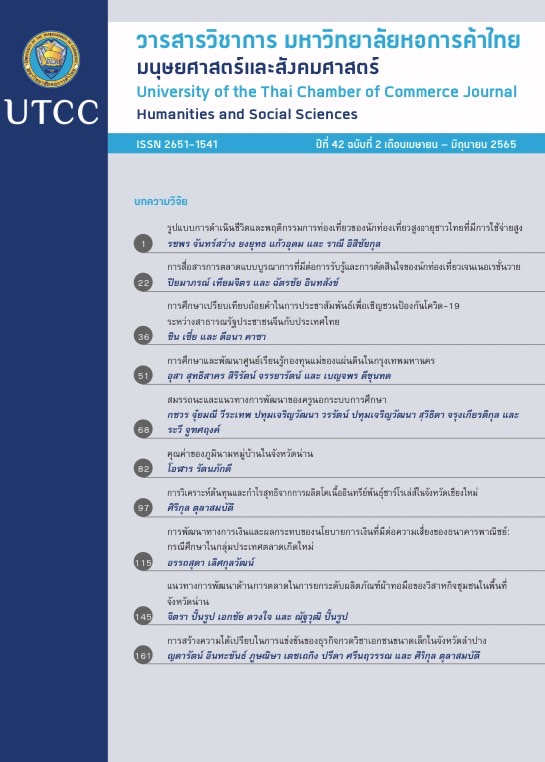Financial Development and Effect of Monetary Policy on Bank Risk: A Case Study in Emerging Market Countries
Main Article Content
Abstract
This research aims to study the effect of monetary policy on commercial bank risk by using the data from 26 Emerging Market Countries between 2000 and 2019. The study also examines the influence of financial development, including the development of banking and capital market in terms of size, activities, and efficiency, on the effect of monetary policy on commercial bank risk. The Generalized Method of Moments estimation result shows that monetary policy significantly affects commercial bank risk. This effect is relatively low, especially when a bank has higher capital and liquidity. Financial development, including the development in terms of size, activities, and efficiency, is lower than the effect of monetary policy on bank risk.
Article Details

This work is licensed under a Creative Commons Attribution-NonCommercial-NoDerivatives 4.0 International License.
ลิขสิทธิ์ของบทความ
ผลงานที่ได้รับการตีพิมพ์ถือเป็นลิขสิทธิ์ของมหาวิทยาลัยหอการค้าไทย ห้ามมิให้นำเนื้อหา ทัศนะ หรือข้อคิดเห็นใด ๆ ของผลงานไปทำซ้ำ ดัดแปลง หรือเผยแพร่ ไม่ว่าทั้งหมดหรือบางส่วนโดยไม่ได้รับอนุญาตเป็นลายลักษณ์อักษรจากมหาวิทยาลัยหอการค้าไทยก่อน
References
Aklan, N. A., Akay, H. K., & Çinar, M. (2014). Is there a risk taking channel of monetary policy in
Turkey? Retrieved July 9, 2020, from
https://pdfs.semanticscholar.org/eb3b /f2bbb77c944a9a11f20e62af1f9fb649402a.pdf
Altunbas, Y., Gambacorta, L., & Marqués-Lbáñez, D. (2012). Do bank characteristics influence the effect of monetary policy on bank risk? Retrieved from
https://www.ecb.europa.eu/pub/pdf/scpwps/ecbwp1427.pdf
Arellano, M., & Bond, S. (1991). Some tests of specification for panel data: Monte Carlo evidence and an application to employment equations. Review of Economic Studies, 58(2), 277-297.
Blundell, R., & Bond, S. (1998). Initial conditions and moment restrictions in dynamic panel data models. Journal of Econometrics, 87(1), 115-143.
Byrne, D., & Kelly, R. (2019). Monetary policy expectations and risk-taking among U.S. banks. Retrieved from https://www.centralbank.ie/docs/default-source/publications/research-technical-papers/06rt19-monetary-policy-expectations-and-risk-taking-among-u-s-banks-(byrne-and-kelly).pdf?sfvrsn=8
Bonfim, D., & Soares, C. (2018). The risk-taking channel of monetary policy – exploring all avenues. Journal of Money, Credit and Banking, 50(7),1507-1541.
Borio, C., & Zhu, H. (2012). Capital regulation, risk-taking and monetary policy: A missing link in the transmission mechanism? Journal of Financial Stability, 8(4), 236-251.
Bourgain, A., Pieretti, P., & Zanaj, S. (2012). Financial openness, disclosure and bank risk-taking in MENA countries. Emerging Markets Review, 13(3), 283-300.
Brana, S., Campmas, A., & Lapteacru, L. (2019). (Un)conventional monetary policy and bank risk-taking: A nonlinear relationship. Economic Modelling, 81, 576-593.
Caselli, G. (2016). Monetary policy, bank risk raking and financial stability: The role of biodiversity in European banking. Retrieved July 10, 2020, from: https://www.euricse.eu/wp-content/uploads/2015/09/Caselli.pdf
Chen, H. (2019). An empirical analysis of the risk taking channel of monetary policy in China –Base on evidence from Chinese listed bank. American Journal of Industrial and Business Management, 9(4), 1033-1044. doi:10.4236/ajibm.2019.94071
Costa, O., Khan, J., Levy, C., Natale, A., & Tanrikulu, O. (2014). Risk in emerging markets: The way forward for leading banks. Retrieved from
Delis, M., Hasan, I., & Mylonidis, N. (2017). The risk -taking channel of monetary policy in the U.S.: Evidence from corporate loan data. Journal of Money, Credit and Banking, 49(1), 187-213.
Drakos, A. A., Kouretas, G. P., & Tsoumas, C. (2016). Ownership, institutions and bank risk-taking in Central and Eastern European countries. International Review of Financial Analysis, 45, 308-319.
European Central Bank. (2021). Financial stability review. Retrieved from https://www.ecb.europa.eu/pub/pdf/fsr/ecb.fsr202105~757f727fe4.en.pdf
Fernández, A. L., González, F., & Suárez, N. (2016). Banking stability, competition, and economic volatility. Journal of Financial Stability, 22, 101-120. https://doi.org/10.1016/j.jfs.2016.01.005
Gambacorta, L. (2009) Monetary policy and the risk-taking channel. BIS Quarterly Review, 4,1-11
International Monetary Fund. (2021). Global financial stability report, April 2021: Preempting a legacy of vulnerabilities. Retrieved from https://www.imf.org/ en/Publications/GFSR/Issues/2021/04/06/global-financial-stability-report-april-2021
Kamran, H. W., Chaudhry, N., Murtaza, M. M., Zafar, N., Yousaf, A., & Nazish, H. (2016). Financial market development, bank risk with key indicators and their impact on financial performance: A study from Pakistan. American Journal of Industrial and Business Management, 6(3), 373-381. doi:10.4236/ajibm.2016.63033
Levine, R. (2002). Bank-based or market-based financial systems: Which is better? Journal of Financial Intermediation, 11(4), 398-428.
Nakashima, K., Shibamoto, M., & Takahashi, K. (2017). Identifying unconventional monetary policy shocks. Kobe, Japan: Kobe University, Research Institute for Economics and Business Administration.
Noman, A. H. M., Gee, C. S., & Isa, C. R. (2017). Does competition improve financial stability of the banking sector in ASEAN countries? An empirical analysis. PLoS ONE, 12(5), e0176546. https://doi.org/10.1371/journal.pone.0176546
Özşuca, E. A., & Akbostancı, E. (2016). An empirical analysis of the risk-taking channel of monetary policy in Turkey. Emerging Markets Finance and Trade, 52(3), 589-609.
Ratanavararak, L., & Ananchotikul, N. (2018). Bank profitability and risk-taking in a low interest rate environment: The case of Thailand. Retrieved from https://www.pier.or.th/wp-content/uploads/2018/07/pier_dp_089.pdf
Ruiz-Porras, A. (2009). Financial structure, financial development and banking fragility: International evidence. Análisis Económico, 56(14), 147-173.
Than, S. H., & Nguyen, L. T. (2020). Financial development, business cycle and bank risk in Southeast Asian countries. Journal of Asian Finance, Economics and Business, 7(3), 127-135.
Vithessonthi, C. (2014). The effect of financial market development on bank risk: Evidence from Southeast Asian countries. International Review of Financial Analysis, 35, 249-260. https://doi.org/10.1016/j.irfa.2014.10.005
Vithessonthi, C., & Tongurai, J. (2016). Financial markets development, business cycles, and bank risk in South America. Research in International Business and Finance, 36, 472-484.
Wang, R., & Luo, H. (2019). Does financial liberalization affect bank risk-taking in China? SAGE Open, 9(4), 1-15.
World Bank. (n.d.). Global financial development database. Retrieved July 10, 2020, from https://www.worldbank.org/en/publication/gfdr/data/global-financial-development-database


